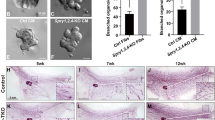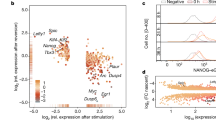Abstract
Transforming growth factor β (TGF-β) is a pluripotent cytokine that regulates cell growth and differentiation in a cell type-dependent fashion. TGF-β exerts its effects through the activation of several signaling pathways. One involves membrane proximal events that lead to nuclear translocation of members of the Smad family of transcriptional regulators. TGF-β can also activate MAPK cascades. Here, we show that TGF-β induces nuclear translocation of the NF-YA subunit of the transcription factor NF-Y by a process that requires activation of the ERK cascade. This results in increased binding of endogenous NF-Y to chromatin and TGF-β-dependent transcriptional regulation of the NF-Y target gene cyclin A2. Interestingly, the kinetics of NF-YA relocalization differs between epithelial cells and fibroblasts. NIH3T3 fibroblasts show an elevated basal level of phosphorylated p38 and delayed nuclear accumulation of NF-YA after TGF-β treatment. In contrast, MDCK cells show low basal p38 activation, higher basal ERK phosphorylation and more rapid localization of NF-YA after induction. Thus, NF-Y activation by TGF-β1 involves ERK1/2 and potentially an interplay between MAPK pathways, thereby opening the possibility for finely tuned transcriptional regulation.
This is a preview of subscription content, access via your institution
Access options
Subscribe to this journal
Receive 50 print issues and online access
$259.00 per year
only $5.18 per issue
Buy this article
- Purchase on Springer Link
- Instant access to full article PDF
Prices may be subject to local taxes which are calculated during checkout







Similar content being viewed by others
References
Adachi M, Fukuda M, Nishida E . (2000). J Cell Biol 148: 849–856.
Alessi DR, Cuenda A, Cohen P, Dudley DT, Saltiel AR . (1995). J Biol Chem 270: 27489–27494.
Attisano L, Wrana JL . (2000). Curr Opin Cell Biol 12: 235–243.
Barlat I, Fesquet D, Brechot C, Henglein B, Dupuy d’Angeac A, Vie A et al. (1993). Cell Growth Differ 4: 105–113.
Barlat I, Henglein B, Plet A, Lamb N, Fernandez A, McKenzie F et al. (1995). Oncogene 11: 1309–1318.
Bhattacharya A, Deng JM, Zhang Z, Behringer R, de Crombrugghe B, Maity SN . (2003). Cancer Res 63: 8167–8172.
Bolognese F, Wasner M, Dohna CL, Gurtner A, Ronchi A, Muller H et al. (1999). Oncogene 18: 1845–1853.
Bulavin DV, Higashimoto Y, Popoff IJ, Gaarde WA, Basrur V, Potapova O et al. (2001). Nature 411: 102–107.
Cheung PC, Campbell DG, Nebreda AR, Cohen P . (2003). EMBO J 22: 5793–5805.
Coustry F, Maity SN, Sinha S, de Crombrugghe B . (1996). J Biol Chem 271: 14485–14491.
de Caestecker M . (2004). Cytokine Growth Factor Rev 15: 1–11.
Derynck R, Zhang YE . (2003). Nature 425: 577–584.
Efimova T, Broome AM, Eckert RL . (2003). J Biol Chem 278: 34277–34285.
Fajas L, Paul C, Vie A, Estrach S, Medema R, Blanchard JM et al. (2001). Mol Cell Biol 21: 2956–2966.
Farina A, Manni I, Fontemaggi G, Tiainen M, Cenciarelli C, Bellorini M et al. (1999). Oncogene 18: 2818–2827.
Frontini M, Imbriano C, Manni I, Mantovani R . (2004). Cell Cycle 3: 217–222.
Hall JP, Davis RJ . (2002). J Cell Biochem 86: 1–11.
Hu Q, Maity SN . (2000). J Biol Chem 275: 4435–4444.
Huang W, Zhao S, Ammanamanchi S, Brattain M, Venkatasubbarao K, Freeman JW . (2005). J Biol Chem 280: 10047–10054.
Huet X, Rech J, Plet A, Vie A, Blanchard JM . (1996). Mol Cell Biol 16: 3789–3798.
Inman GJ, Nicolas FJ, Hill CS . (2002). Mol Cell 10: 283–294.
Janssens V, Goris J . (2001). Biochem J 353: 417–439.
Kahle J, Baake M, Doenecke D, Albig W . (2005). Mol Cell Biol 25: 5339–5354.
Kurisaki A, Kose S, Yoneda Y, Heldin CH, Moustakas A . (2001). Mol Biol Cell 12: 1079–1091.
Lindahl GE, Chambers RC, Papakrivopoulou J, Dawson SJ, Jacobsen MC, Bishop JE et al. (2002). J Biol Chem 277: 6153–6161.
Maity SN, Sinha S, Ruteshouser EC, de Crombrugghe B . (1992). J Biol Chem 267: 16574–16580.
Manni I, Mazzaro G, Gurtner A, Mantovani R, Haugwitz U, Krause K et al. (2001). J Biol Chem 276: 5570–5576.
Mantovani R . (1999). Gene 239: 15–27.
Marziali G, Perrotti E, Ilari R, Coccia EM, Mantovani R, Testa U et al. (1999). Blood 93: 519–526.
Moriguchi T, Kuroyanagi N, Yamaguchi K, Gotoh Y, Irie K, Kano T et al. (1996). J Biol Chem 271: 13675–13679.
Nicolas FJ, De Bosscher K, Schmierer B, Hill CS . (2004). J Cell Sci 117: 4113–4125.
Park SH, Lee SR, Kim BC, Cho EA, Patel SP, Kang HB et al. (2002). J Biol Chem 277: 5168–5174.
Philips A, Chambeyron S, Lamb N, Vie A, Blanchard JM . (1999). Oncogene 18: 6222–6232.
Pierreux CE, Nicolas FJ, Hill CS . (2000). Mol Cell Biol 20: 9041–9054.
Plet A, Huet X, Algarte M, Rech J, Imbert J, Philips A et al. (1997). Oncogene 14: 2575–2583.
Shi Y, Massague J . (2003). Cell 113: 685–700.
Siegel PM, Massague J . (2003). Nat Rev Cancer 3: 807–821.
Sinha S, Maity SN, Lu J, de Crombrugghe B . (1995). Proc Natl Acad Sci USA 92: 1624–1628.
Tan Y, Rouse J, Zhang A, Cariati S, Cohen P, Comb MJ . (1996). EMBO J 15: 4629–4642.
ten Dijke P, Hill CS . (2004). Trends Biochem Sci 29: 265–273.
Testa A, Donati G, Yan P, Romani F, Huang TH, Vigano MA et al. (2005). J Biol Chem 280: 13606–13615.
Vignais ML, Sadowski HB, Watling D, Rogers NC, Gilman M . (1996). Mol Cell Biol 16: 1759–1769.
Waite KA, Eng C . (2003). Nat Rev Genet 4: 763–773.
Wang W, Zhou G, Hu MC, Yao Z, Tan TH . (1997). J Biol Chem 272: 22771–22775.
Wysocka J, Reilly PT, Herr W . (2001). Mol Cell Biol 21: 3820–3829.
Xiao Z, Liu X, Henis YI, Lodish HF . (2000). Proc Natl Acad Sci USA 97: 7853–7858.
Xu L, Kang Y, Col S, Massague J . (2002). Mol Cell 10: 271–282.
Yamaguchi K, Shirakabe K, Shibuya H, Irie K, Oishi I, Ueno N et al. (1995). Science 270: 2008–2011.
Yingling JM, Blanchard KL, Sawyer JS . (2004). Nat Rev Drug Discovery 3: 1011–1022.
Young PR, McLaughlin MM, Kumar S, Kassis S, Doyle ML, McNulty D et al. (1997). J Biol Chem 272: 12116–12121.
Yun J, Chae HD, Choi TS, Kim EH, Bang YJ, Chung J et al. (2003). J Biol Chem 278: 36966–36972.
Acknowledgements
We thank R Mantovani (University of Modene, Italy) for discussions and for providing antibodies and plasmids, K Matsumoto for providing plasmids. We also thank Annick Vié for her excellent technical support. This work was funded by grants from l’Association pour la Recherche sur le Cancer (contracts 3304 to RAH, 4209 and 3446 to MLV) and La Ligue Contre le Cancer. SC was supported by the Ch Oberling Foundation.
Author information
Authors and Affiliations
Corresponding author
Additional information
Supplementary Information accompanies the paper on the Oncogene website (http://www.nature.com/onc).
Supplementary information
Rights and permissions
About this article
This article is cited by
-
COL11A1 promotes tumor progression and predicts poor clinical outcome in ovarian cancer
Oncogene (2014)
-
A chromatin-modifying function of JNK during stem cell differentiation
Nature Genetics (2012)



